check engine MITSUBISHI L200 2015 (in English) Owner's Guide
[x] Cancel search | Manufacturer: MITSUBISHI, Model Year: 2015, Model line: L200, Model: MITSUBISHI L200 2015Pages: 418, PDF Size: 25.8 MB
Page 311 of 418
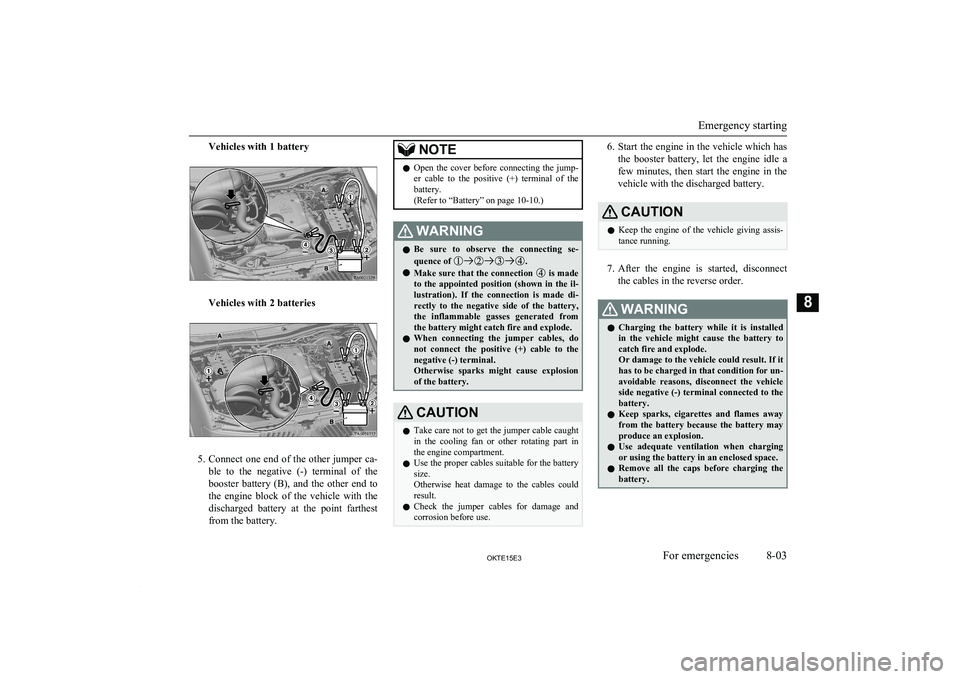
Vehicles with 1 battery
Vehicles with 2 batteries
5.Connect one end of the other jumper ca-
ble to the negative (-) terminal of the
booster battery (B), and the other end to
the engine block of the vehicle with the
discharged battery at the point farthest from the battery.
NOTEl Open the cover before connecting the jump-
er cable to the positive (+) terminal of thebattery.
(Refer to “Battery” on page 10-10.)WARNINGl Be sure to observe the connecting se-
quence of .
l Make sure that the connection
is made
to the appointed position (shown in the il-
lustration). If the connection is made di-
rectly to the negative side of the battery, the inflammable gasses generated from the battery might catch fire and explode.
l When connecting the jumper cables, do
not connect the positive (+) cable to the
negative (-) terminal.
Otherwise sparks might cause explosion
of the battery.
CAUTIONl Take care not to get the jumper cable caught
in the cooling fan or other rotating part in
the engine compartment.
l Use the proper cables suitable for the battery
size.
Otherwise heat damage to the cables could
result.
l Check the jumper cables for damage and
corrosion before use.6. Start the engine in the vehicle which has
the booster battery, let the engine idle a
few minutes, then start the engine in the vehicle with the discharged battery.CAUTIONl Keep the engine of the vehicle giving assis-
tance running.
7. After the engine is started, disconnect
the cables in the reverse order.
WARNINGl Charging the battery while it is installed
in the vehicle might cause the battery to
catch fire and explode.
Or damage to the vehicle could result. If it has to be charged in that condition for un- avoidable reasons, disconnect the vehicle
side negative (-) terminal connected to the
battery.
l Keep sparks, cigarettes and flames away
from the battery because the battery may
produce an explosion.
l Use adequate ventilation when charging
or using the battery in an enclosed space.
l Remove all the caps before charging the
battery.
Emergency starting
8-03OKTE15E3For emergencies8
Page 312 of 418
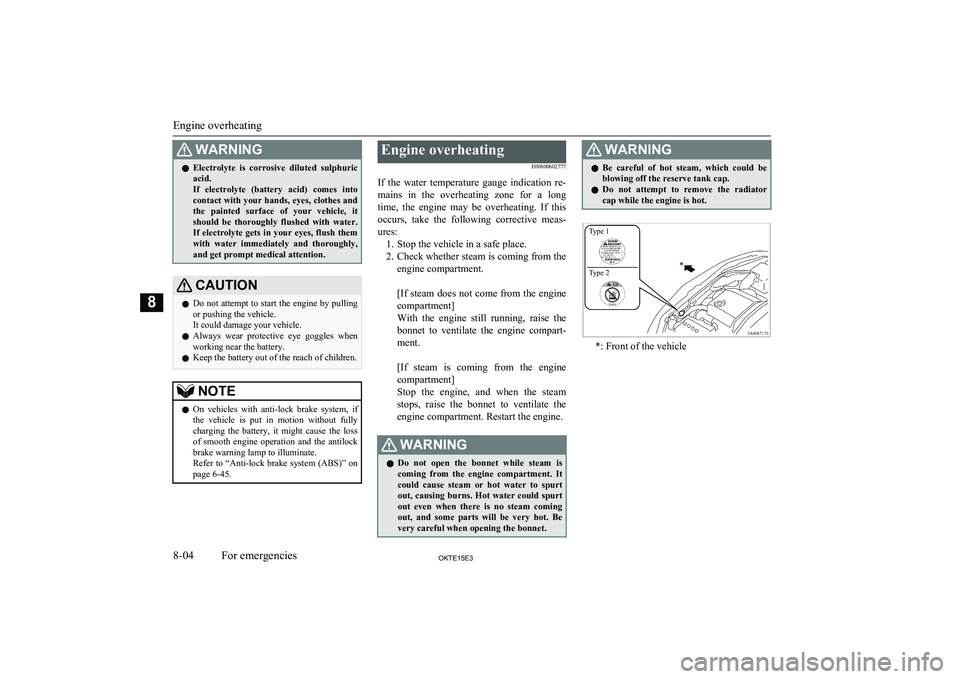
WARNINGlElectrolyte is corrosive diluted sulphuric
acid.
If electrolyte (battery acid) comes into contact with your hands, eyes, clothes and
the painted surface of your vehicle, it should be thoroughly flushed with water.If electrolyte gets in your eyes, flush them
with water immediately and thoroughly, and get prompt medical attention.CAUTIONl Do not attempt to start the engine by pulling
or pushing the vehicle.
It could damage your vehicle.
l Always wear protective eye goggles when
working near the battery.
l Keep the battery out of the reach of children.NOTEl
On vehicles with anti-lock brake system, if
the vehicle is put in motion without fully charging the battery, it might cause the loss
of smooth engine operation and the antilock brake warning lamp to illuminate.
Refer to “Anti-lock brake system (ABS)” on
page 6-45.Engine overheating
E00800602777
If the water temperature gauge indication re-
mains in the overheating zone for a long
time, the engine may be overheating. If this occurs, take the following corrective meas-
ures: 1. Stop the vehicle in a safe place.
2. Check whether steam is coming from the
engine compartment.
[If steam does not come from the engine
compartment]
With the engine still running, raise the bonnet to ventilate the engine compart-
ment.
[If steam is coming from the engine
compartment]
Stop the engine, and when the steam
stops, raise the bonnet to ventilate the engine compartment. Restart the engine.WARNINGl Do not open the bonnet while steam is
coming from the engine compartment. It
could cause steam or hot water to spurt out, causing burns. Hot water could spurt
out even when there is no steam coming out, and some parts will be very hot. Be
very careful when opening the bonnet.WARNINGl Be careful of hot steam, which could be
blowing off the reserve tank cap.
l Do not attempt to remove the radiator
cap while the engine is hot.
*: Front of the vehicle
Engine overheating
8-04OKTE15E3For emergencies8 Type 1
Type 2
Page 313 of 418
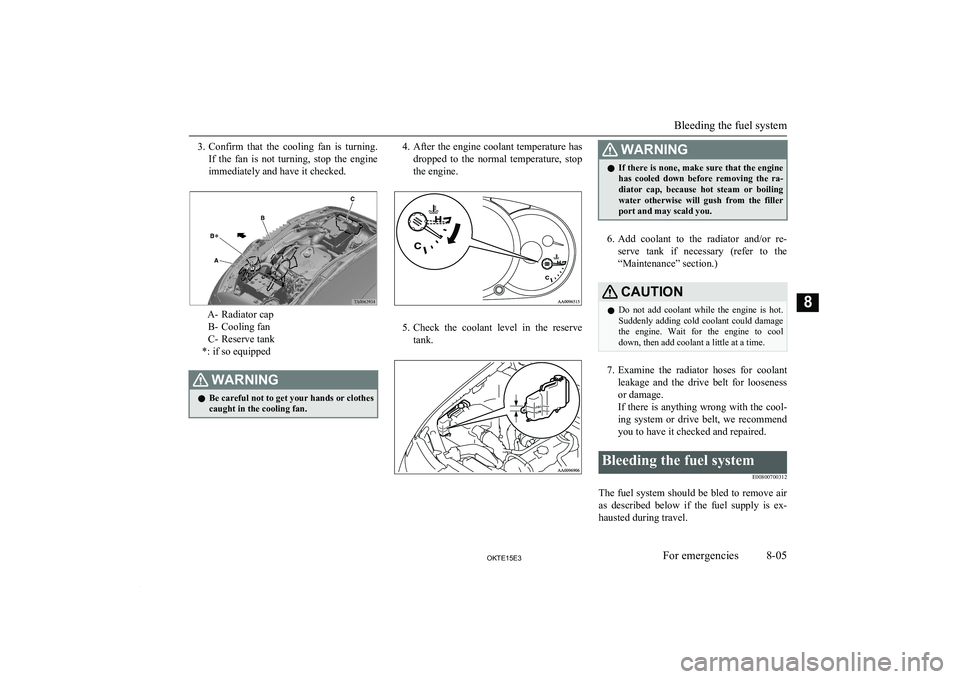
3.Confirm that the cooling fan is turning.
If the fan is not turning, stop the engine
immediately and have it checked.
A- Radiator cap B- Cooling fan
C- Reserve tank
*: if so equipped
WARNINGl Be careful not to get your hands or clothes
caught in the cooling fan.4. After the engine coolant temperature has
dropped to the normal temperature, stop the engine.
5. Check the coolant level in the reserve
tank.
WARNINGl If there is none, make sure that the engine
has cooled down before removing the ra-
diator cap, because hot steam or boiling water otherwise will gush from the fillerport and may scald you.
6. Add coolant to the radiator and/or re-
serve tank if necessary (refer to the
“Maintenance” section.)
CAUTIONl Do not add coolant while the engine is hot.
Suddenly adding cold coolant could damage
the engine. Wait for the engine to cool
down, then add coolant a little at a time.
7. Examine the radiator hoses for coolant
leakage and the drive belt for looseness
or damage.
If there is anything wrong with the cool-
ing system or drive belt, we recommend
you to have it checked and repaired.
Bleeding the fuel system
E00800700312
The fuel system should be bled to remove air
as described below if the fuel supply is ex- hausted during travel.
Bleeding the fuel system
8-05OKTE15E3For emergencies8
Page 314 of 418
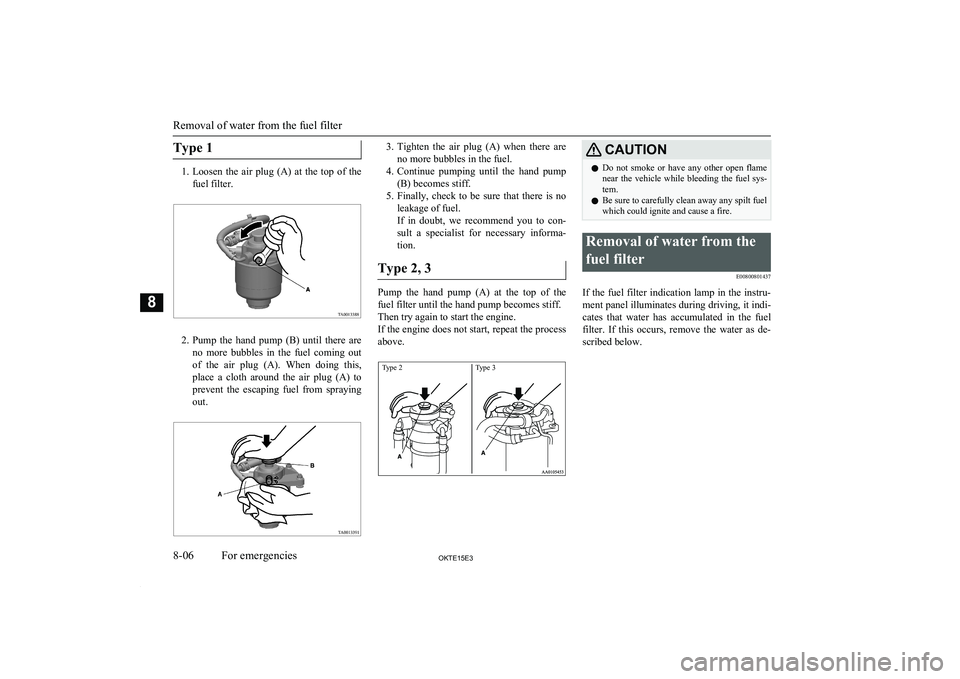
Type 1
1.Loosen the air plug (A) at the top of the
fuel filter.
2. Pump the hand pump (B) until there are
no more bubbles in the fuel coming out
of the air plug (A). When doing this, place a cloth around the air plug (A) toprevent the escaping fuel from spraying
out.
3. Tighten the air plug (A) when there are
no more bubbles in the fuel.
4. Continue pumping until the hand pump
(B) becomes stiff.
5. Finally, check to be sure that there is no
leakage of fuel.
If in doubt, we recommend you to con-
sult a specialist for necessary informa- tion.
Type 2, 3
Pump the hand pump (A) at the top of the fuel filter until the hand pump becomes stiff.Then try again to start the engine.
If the engine does not start, repeat the process
above.
Type 2Type 3
CAUTIONl Do not smoke or have any other open flame
near the vehicle while bleeding the fuel sys-
tem.
l Be sure to carefully clean away any spilt fuel
which could ignite and cause a fire.Removal of water from the
fuel filter E00800801437
If the fuel filter indication lamp in the instru-ment panel illuminates during driving, it indi-
cates that water has accumulated in the fuel filter. If this occurs, remove the water as de-
scribed below.
Removal of water from the fuel filter
8-06OKTE15E3For emergencies8
Page 315 of 418
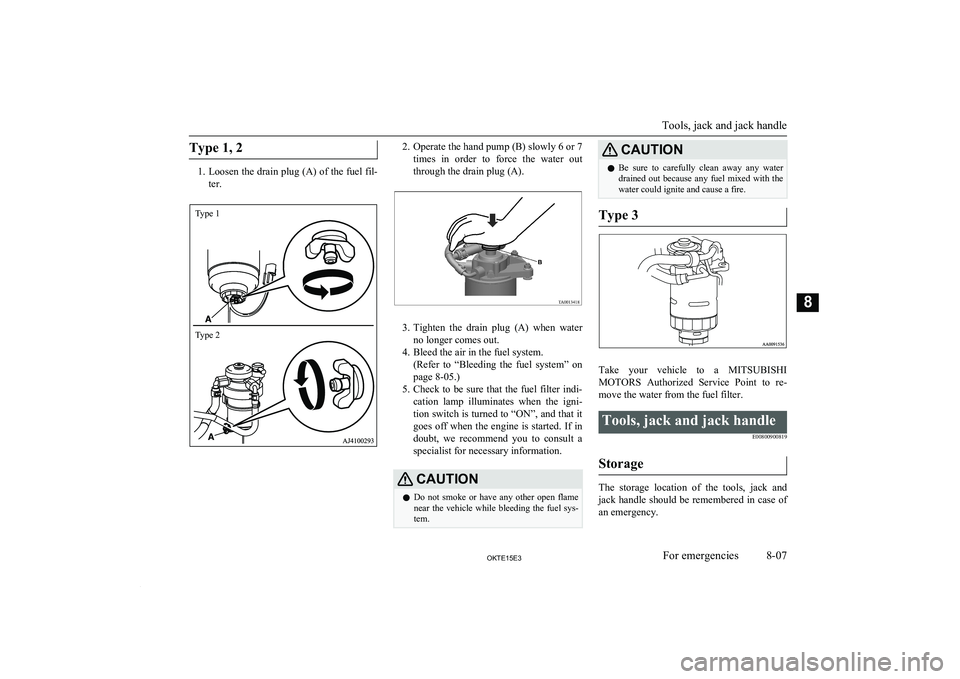
Type 1, 2
1.Loosen the drain plug (A) of the fuel fil-
ter.
2. Operate the hand pump (B) slowly 6 or 7
times in order to force the water out
through the drain plug (A).
3. Tighten the drain plug (A) when water
no longer comes out.
4. Bleed the air in the fuel system. (Refer to “Bleeding the fuel system” onpage 8-05.)
5. Check to be sure that the fuel filter indi-
cation lamp illuminates when the igni- tion switch is turned to “ON”, and that it
goes off when the engine is started. If in
doubt, we recommend you to consult a specialist for necessary information.
CAUTIONl Do not smoke or have any other open flame
near the vehicle while bleeding the fuel sys- tem.CAUTIONl Be sure to carefully clean away any water
drained out because any fuel mixed with the
water could ignite and cause a fire.
Type 3
Take your vehicle to a MITSUBISHI
MOTORS Authorized Service Point to re-
move the water from the fuel filter.
Tools, jack and jack handle
E00800900819
Storage
The storage location of the tools, jack andjack handle should be remembered in case ofan emergency.
Tools, jack and jack handle
8-07OKTE15E3For emergencies8Type 1
Type 2
Page 341 of 418
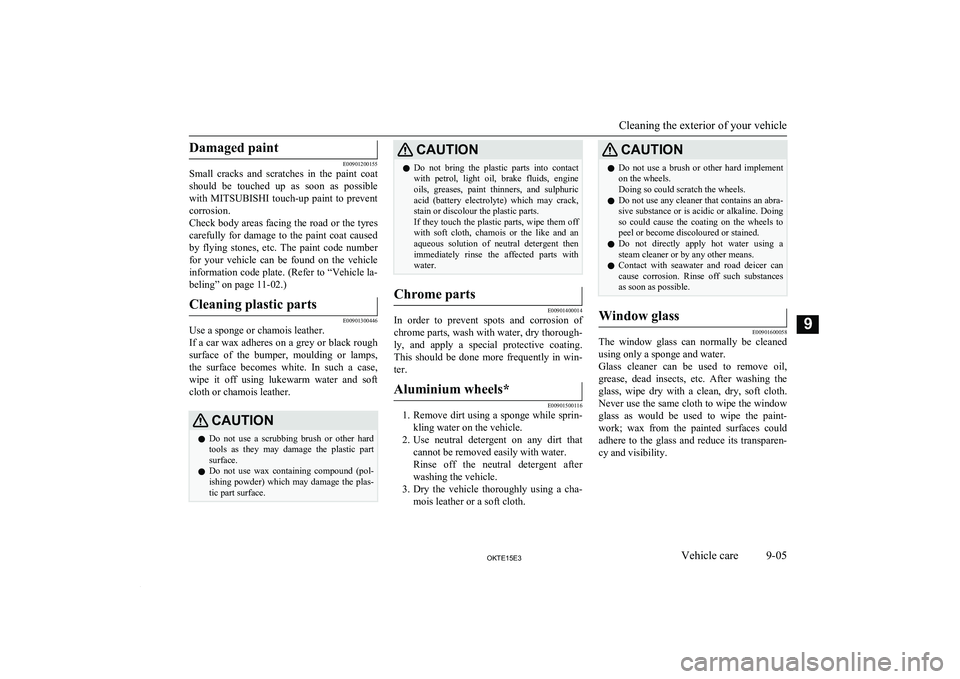
Damaged paint
E00901200155
Small cracks and scratches in the paint coat
should be touched up as soon as possible
with MITSUBISHI touch-up paint to prevent
corrosion.
Check body areas facing the road or the tyres
carefully for damage to the paint coat caused
by flying stones, etc. The paint code number
for your vehicle can be found on the vehicle information code plate. (Refer to “Vehicle la-
beling” on page 11-02.)
Cleaning plastic parts
E00901300446
Use a sponge or chamois leather.
If a car wax adheres on a grey or black rough surface of the bumper, moulding or lamps, the surface becomes white. In such a case,
wipe it off using lukewarm water and soft cloth or chamois leather.
CAUTIONl Do not use a scrubbing brush or other hard
tools as they may damage the plastic part surface.
l Do not use wax containing compound (pol-
ishing powder) which may damage the plas-
tic part surface.CAUTIONl Do not bring the plastic parts into contact
with petrol, light oil, brake fluids, engine
oils, greases, paint thinners, and sulphuric acid (battery electrolyte) which may crack,stain or discolour the plastic parts.
If they touch the plastic parts, wipe them off
with soft cloth, chamois or the like and an aqueous solution of neutral detergent thenimmediately rinse the affected parts with
water.Chrome parts
E00901400014
In order to prevent spots and corrosion of
chrome parts, wash with water, dry thorough-
ly, and apply a special protective coating.
This should be done more frequently in win- ter.
Aluminium wheels*
E00901500116
1. Remove dirt using a sponge while sprin-
kling water on the vehicle.
2. Use neutral detergent on any dirt that
cannot be removed easily with water.
Rinse off the neutral detergent after
washing the vehicle.
3. Dry the vehicle thoroughly using a cha-
mois leather or a soft cloth.
CAUTIONl Do not use a brush or other hard implement
on the wheels.
Doing so could scratch the wheels.
l Do not use any cleaner that contains an abra-
sive substance or is acidic or alkaline. Doing
so could cause the coating on the wheels to peel or become discoloured or stained.
l Do not directly apply hot water using a
steam cleaner or by any other means.
l Contact with seawater and road deicer can
cause corrosion. Rinse off such substances as soon as possible.Window glass
E00901600058
The window glass can normally be cleaned
using only a sponge and water.
Glass cleaner can be used to remove oil, grease, dead insects, etc. After washing the
glass, wipe dry with a clean, dry, soft cloth. Never use the same cloth to wipe the window glass as would be used to wipe the paint-
work; wax from the painted surfaces could
adhere to the glass and reduce its transparen-
cy and visibility.
Cleaning the exterior of your vehicle
9-05OKTE15E3Vehicle care9
Page 344 of 418

Service precautionsE01000100706
Adequate care of your vehicle at regular in- tervals serves to preserve the value and ap-
pearance as long as possible.
Maintenance items as described in this own- er’s manual can be performed by the owner.We recommend you to have the periodic in-
spection and maintenance performed by a MITSUBISHI MOTORS Authorized Service
Point or another specialist.
In the event a malfunction or other problem is discovered, we recommend you to have it
checked and repaired. This section contains information on inspection maintenance pro- cedures that you can do yourself. Follow the
instructions and cautions for each of the vari- ous procedures.WARNINGl When checking or servicing the inside of
the engine compartment, make sure the
engine is switched off and has had a chance to cool down.
l If it is necessary to do work in the engine
compartment with the engine running, be
especially careful that your clothing, hair, etc., does not become caught by the fans,
drive belts, or other moving parts.WARNINGl For vehicle with air conditioning, the fan
may turn on automatically even if the en-
gine is not running; turn the ignition key
to “LOCK” position and remove the key to ensure safety while you work in the en-
gine compartment.
l Do not smoke, cause sparks or allow open
flames around fuel or battery. The fumesare flammable.
l Be extremely cautious when working
around the battery. It contains poisonous
and corrosive sulphuric acid.
l Do not get under your vehicle with just
the body jack supporting it. Always use
automotive jack stands.
l Improper handling of components and
materials used in the vehicle can endanger
your personal safety. We recommend you to consult a specialist for necessary infor-
mation.Catalytic converter
E01000200925
For ordinary use, there are no particular pre-cautions.
The exhaust gas scavenging devices used
with the catalytic converter are extremely ef- ficient for the reduction of noxious gases.
The catalytic converter is installed in the ex- haust system.
It is important to keep the engine properly
tuned to ensure proper catalyst operation andprevent possible catalyst damage.CAUTIONl Damage to the catalytic converter can result
if your vehicle is not kept in proper operat-ing condition. In the event of an engine mal-
function particularly involving engine mis-
fire or other apparent loss of performance, have your vehicle serviced promptly.
Continued operation of your vehicle with a
severe overheated condition may result in possible damage to the converter and vehi-cle.WARNINGl As with any vehicle, do not park or oper-
ate this vehicle in areas where combusti-
ble materials such as dry grass or leaves
can come in contact with a hot exhaust since a fire could occur.
l Paint should not be applied to the catalyt-
ic converter.
The catalytic converter itself gets hot quickly,
and may be damaged if overheated. The fol- lowing points should be noted in order to pre-vent the ignition of unburned fuel within the
catalytic converter.
Service precautions
10-02OKTE15E3Maintenance10
Page 346 of 418

Support the bonnet by inserting the supportbar in its slot.CAUTIONl Note that the support bar may disengage the
bonnet if the open bonnet is lifted by astrong wind.
l Always insert the support bar into the hole
provided specifically for this purpose. Sup- porting the bonnet at any other location
could result in the support bar slipping out
and lead to an accident.
To close
Unlatch the support bar and clip it in its hold-
er.
Slowly lower the bonnet to a position about
20 cm above the closed position, then let it drop.NOTEl If this does not close the bonnet, release it
from a slightly higher position.
l Do not press down the bonnet hard with a
hand as it may damage the bonnet.CAUTIONl Be careful that hands or fingers are not trap-
ped when closing the bonnet.
l Before driving, make sure that the bonnet is
securely locked. An incompletely locked bonnet can suddenly open while driving.
This can be extremely dangerous.Engine oil
E01000402820
To check and refill engine oil
A- Minimum level B- Maximum level
C- Oil replacement indication mark
Type 1Type 2
The engine oil used has a significant effect on the engine’s performance, service life and
startability. Be sure to use oil of the recom- mended quality and appropriate viscosity.
All engines consume a certain amount of oil during normal operation. Therefore, it is im-portant to check the oil level at regular inter-
vals or before starting a long trip. 1. Park the car on a horizontal surface.
2. Switch off the engine.
3. Wait a few minutes.
Engine oil
10-04OKTE15E3Maintenance10
Page 347 of 418

4.Remove the dipstick and wipe it with a
clean cloth.
5. Reinsert the dipstick as far as it goes.
6. Remove the dipstick and read the oil lev- el, which should always be within the
range indicated.
7. If the oil level is below the specified
limit, remove the cap located on the cyl-inder head cover and add enough oil to
raise the level to within the specified
range. Do not overfill to avoid engine
damage. Be sure to use the specified en-
gine oil and do not mix various types of
oil.
8. After adding oil, close the cap securely.
9. Confirm the oil level by repeating step 4
to 6.
Use only the recommended oils with an ACEA or API classification as specified inthis manual.NOTEl Check or refill the oil according to the fol-
lowing manner.
• When the oil level is checked in step 6
above, check it on a low side of the dip-
stick because it is different in appearance
of oil level in the two sides of the dip-
stick.NOTE• On vehicles without diesel particulate fil-
ter (DPF), the oil level should be within the range (A) to (B) on the dipstick.
• On vehicles with DPF, the oil level should
be within the range (A) to (C) (oil re- placement indication mark) on the dip-
stick.
If the oil level is beyond the oil replace-
ment indication mark (C), replace the oil as soon as possible.
Then, the oil should be refilled to the
maximum level (B).
• On vehicles with DPF, the engine oil will
increase due to a little fuel getting mixed in the engine oil when the DPF regener-
ates to burn away the PM (particulate
matter). However, it does not indicate a malfunction.
l The engine oil will deteriorate rapidly if the
vehicle is subjected to severe conditions, re-
quiring earlier oil replacement. Please refer to the maintenance schedule.
l For handling of used engine oils, refer to
page 2-05.Selection of engine oil
Vehicles without diesel particu-
late filter (DPF)
l Select engine oil of the proper SAE vis-
cosity number according to the atmos-pheric temperature.
l Use engine oil conforming to the follow-
ing classification: • ACEA classification: “For service A1/ B1, A3/B3, A3/B4,
A5/B5”
• API classification: “For service CF-4”
Engine oil
10-05OKTE15E3Maintenance10
Page 348 of 418

NOTElUse of additives is not recommended since
they may reduce the effectiveness of addi-
tives already included in the engine oil. It may result in failure of the mechanical as-
sembly.
Vehicles with diesel particulate
filter (DPF)
l Select engine oil of the proper SAE vis-
cosity number according to the atmos- pheric temperature.
l Use engine oil conforming to the follow-
ing classification: • ACEA classification: “For service C1, C2, C3 or C4”
• JASO classification: “For service DL-1”
If those classifications are not available, contact a MITSUBISHI MOTORS Au-
thorized Service Point.
NOTEl Use of additives is not recommended since
they may reduce the effectiveness of addi-
tives already included in the engine oil. It may result in failure of the mechanical as-
sembly.Engine coolant
E01000502153
To check the coolant level
A transparent coolant reserve tank (A) is lo-cated in the engine compartment.
The coolant level in this tank should be kept
between the “LOW” and “FULL” marks when measured while the engine is cold.
*: Front of the vehicle
To add coolant
The cooling system is a closed system and
normally the loss of coolant should be very
slight. A noticeable drop in the coolant level
could indicate leakage. If this occurs, we rec- ommend you to have the system checked as
soon as possible.
If the level should drop below the “LOW” level on the reserve tank, open the lid and
add coolant.
Also, if the reserve tank is completely empty, remove the radiator cap (B) and add coolant until the level reaches the filler neck.
WARNINGl Do not open the radiator cap (B) while the
engine is hot. The coolant system is under
pressure and any hot coolant escaping
could cause severe burns.
Anti-freeze
The engine coolant contains an ethylene gly-
col anti-corrosion agent. The cylinder head and water pump housing are cast aluminium
alloy, and periodic changing of the engine coolant is necessary to prevent corrosion of
these parts.
Use “ MITSUBISHI MOTORS GENUINE
SUPER LONG LIFE COOLANT” or equiva- lent.
Engine coolant
10-06OKTE15E3Maintenance10 Type 1
Type 2